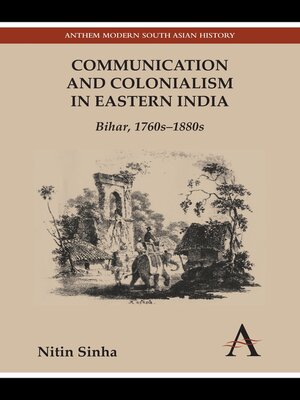Communication and Colonialism in Eastern India
ebook ∣ Bihar, 1760s–1880s · Anthem Modern South Asian History
By Nitin Sinha

Sign up to save your library
With an OverDrive account, you can save your favorite libraries for at-a-glance information about availability. Find out more about OverDrive accounts.
Find this title in Libby, the library reading app by OverDrive.



Search for a digital library with this title
Title found at these libraries:
| Library Name | Distance |
|---|---|
| Loading... |
Through a regional focus on Bihar between the 1760s and 1880s, 'Communication and Colonialism in Eastern India' reveals the shifting and contradictory nature of the colonial state's policies and discourses on communication. The volume explores the changing relationship between trade, transport and mobility in India, as evident in the trading and mercantile networks operating at various scales of the economy. Of crucial importance to this study are the ways in which knowledge about roads and routes was collected through practices of travel, tours, surveys, and map-making, all of which benefited the state in its attempts to structure a regime that would regulate 'undesirable' forms of mobility.
|Communication and Colonialism in Eastern India: Bihar, 1760s–1880s' departs from the dominant scholarship in South Asian history that focuses narrowly on railways, and instead argues that any discussion of railway-generated changes needs to see such changes, at least up to the 1880s, as situated amidst existing patterns and networks of circulation within which roads and ferries were crucial. The volume also offers a detailed exploration of early colonial policies on road building and ferry improvement – an area that has hitherto remained unexplored.
Just as the new development of steam technology required and necessitated 'lateral growth' alongside the older technologies, so too were trade linkages marked by the interconnectedness of local and supra-local ties in which the world of peddlers intersected with that of native merchants and capitalist sahibs. This volume contends that the history of colonial communication is not a story of 'displacement' alone – either of one means by another or of one group by another – but also of realignment. Combining the understanding of production of knowledge about routes with the ways the practice of surveying and mapping led to territorial construction of the national space of India, this book reinterprets the 'colonial state–space' as constituting a series of layered components, both of 'inherited spaces and networks' from pre-colonial times and of the processes of objectification that colonial rule initiated.
The aim of this volume is to contribute to the 'history of social spaces', a new field of study in which neither cultural nor economic discourse is overridden by the other. This is achieved via a micro-historical study of local circulatory regimes, together with an exploration of colonial and imperial cultural discourses on communications.







